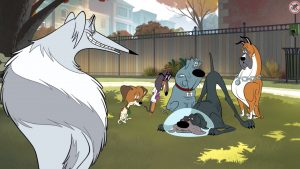
This article contains spoilers for both Alien: Romulus and Alien: Isolation.
It’s a green, blinking box. Yet every time it appeared in the background of Alien: Romulus, a cold chill went down the spines of possibly millions of viewers, including this writer. That’s because if you ever played Alien: Isolation, Creative Assembly’s relentless survival horror game from 2014, those proverbial telephone boxes are the stuff of nightmares and lingering trauma.
Appearing in more than one scene during Fede Alvarez’s love letter to the larger Alien franchise, these “registration points,” or emergency telephone booths, are littered throughout the Renaissance Space Station in Alien: Romulus. You can see one in a scene where Cailee Spaeny’s Rain and Archie Renaux’s Tyler discuss how best to circumnavigate a hallway filled with facehuggers. The emergency comm-links also appear when Andy (David Jonsson) explains to the humans that they’re going to need pulse rifles.
Pulse rifles, you say? Try crawling through the Sevastopol Space Station with only a nail gun! That was the experience gamers endured for large stretches of Alien: Isolation, a video game whose lone, false sense of sanctuary came from these emergency “registration points,” which allowed you to save your progress… assuming you lived long enough, and quietly enough, not to be skewered by the Alien stalking your every step. That’s right, even mid-save, you could lose your progress and life to the “perfect organism.”
So it’s a devilish easter egg (one of many to the whole series). But its inclusion in Romulus also marks the first time an Alien movie has acknowledged the events of Alien: Isolation are canonical. And given the video game stars Ellen Ripley’s daughter, Amanda, this fundamentally changes the timeline of the series…
Rewriting the Tragedy of Aliens
Much like how a deleted scene set at Hadley’s Hope influenced the plot of Alien: Romulus, the entire setup of Alien: Isolation is borne from the most poignant subplot deleted out of that same movie: Ellen Ripley had a daughter. This secret is well known to fans who have seen the extended cut of Aliens; it was even the dramatic selling point that convinced Sigourney Weaver to come back for a much belated sequel.
For those who haven’t seen the longer cut: the revelation comes shortly after Ripley (Weaver) is salvaged from cryosleep during the opening moments of James Cameron’s sequel. She is then informed by a friendly Weyland-Yutani suit named Burke (Paul Reiser) that she’s been frozen for 57 years while her escape pod floated through the cosmos. Worse, Ripley is informed her daughter has died of cancer as an elderly woman less than 12 months before the events of the sequel. Ripley is thus a mother grieving a lost child when she meets Newt (Carrie Henn) in the most complete version of Cameron’s story.
It’s brutal. However, Amanda’s ghost over Aliens becomes so much bleaker once you accept the events of Alien: Isolation are canon—as Alvarez and Disney have done with Alien: Romulus.
In Isolation, Amanda isn’t just a lost child in Ellen’s memory, but a lonely, searching adult daughter who wants answers about what happened to her mother. It is how a synthetic named Samuels is able to convince Amanda, who like Ellen works blue collar jobs for the Company, to board a Weyland-Yutani vessel headed toward the Sevastopol in the year 2137 (about five years before the events of Romulus). Like the Romulus’ Renaissance, the Sevastopol is a space station, albeit much bigger. Run by one of Weyland’s cheap competitors, Seegson, the Sevastopol is essentially a deep space airport. And one of their docking scavengers now claims to have discovered the flight recorder of the Nostromo with a message left by Amanda’s mother, Ellen. Little could even the Weyland staffers anticipate that the scavenger ship also picked up… a parasite.
By the time the gamer gets to the Sevastopol, all hell’s broken loose. The space station is in disarray and survivors compete for resources while evading the Alien hunting anyone who makes too much noise. While we won’t summarize the whole game, suffice to say a lot of bad stuff happens and by the end, the only survivor is Amanda… maybe? Things certainly look grim as she floats through the blackness of space and the oxygen of her spacesuit nears zero. At that moment, mysterious lights from an unseen vessel illuminate her face and—nothing. Obviously, Isolation set up a sequel that was never made. However, the mystery of Amanda’s fate already paints Weyland-Yutani and Aliens in an even more insidious light.
Should Amanda Ripley have really survived the events of that game, surely she would have reported to the Company the horrors she witnessed on the Sevastopol, in which case, even 30 years later there would be presumably somebody on the Weyland-Yutani board who knew what Ellen was ranting about when she explained what happened to her crew on the Nostromo. So either the Company lied to Ellen about what they knew, and worse kept information about her daughter experiencing a similar terror… or they purposefully withheld what happened to her daughter.
Could Weyland-Yutani have lied to Ellen about her daughter’s fate, perhaps even covering up how she might’ve really died 35 years earlier? Are the A2s a bit twitchy?
The New Timeline from Prometheus to Alien: Romulus Makes Weyland-Yutani More Evil
Alien: Romulus confirming all of the above is canon is interesting. But when it’s coupled with the other revelations provided in Romulus by that film’s surprise (and some might say tasteless) cameo of “Ian Holm” as an A2 android named Rook, the picture it paints of Weyland-Yutani is somehow even more diabolical.
During Rook’s several scenes of lore-building, the synthetic reveals the Company was well aware of what occurred on the Nostromo, because they received secret reports of the impending disaster presumably broadcast by Mother and the robot Ash before Ripley blew up the ship. Furthermore, Rook informs us the Company has been desperate to acquire the organism since recovering the “Prometheus files,” presumably records of Peter Weyland’s ill-fated trip across the stars on the Prometheus space vessel.
Ever since receiving intel of what Rook deems the “Prometheus strain,” the Company has been eager to reverse engineer the black goo from Prometheus (2012) in order to extend human life toward immortality—just like the xenomorph that can survive even in the black void of space. When you connect the dots painted by Rook, a dire picture of the timeline comes into focus.
After receiving reports (interstellar transmissions?) of the Prometheus disaster, Weyland-Yutani made it a mission to acquire the black goo, or “Prometheus strain,” that was used in that film to turn Charlie Holloway into a monster and, eventually, birth a xenomorph prototype. Perhaps the Company returned to LV-223 (the moon where most of Prometheus takes place) and discovered the other Engineer derelicts held no such goo… or perhaps more nightmares awaited those who dared not heed Elizabeth Shaw’s warning?
Whatever the reason, Alien: Romulus confirms the events of Alien occurred because the Company had mandatory protocols in place to find a similar site with more biological evidence of the Engineers’ handiwork. Or that “any systematized transmission indicating a possible intelligent origin must be investigated,” as Ash threatens in Alien. Given that the Company never returned to the site until Ripley told them about the derelict on LV-426 in Aliens, we can surmise Weyland-Yutani didn’t know about the derelict on that specific moon… but they were looking for signals of any such crash.
This is where Alien: Isolation comes in. After all, the game shrewdly gives a sensible explanation about why Weyland-Yutani didn’t know about the derelict on LV-426: scavengers (the same ones who recovered Ellen’s flight recording for Amanda) switched off the transmission, which actually turned out to be an S.O.S. warning to stay away.
But while Isolation clears up that plot inconsistency, it also leaves more insidious threads dangling, and the implications are grim. If the Company did not know for certain until Isolation what occurred aboard the Nostromo—perhaps they only realized that crew was killed off by a xenomorph because of the flight recorder Amanda verified?—this means they knew a single xenomorph infection wiped out an entire space station on the Sevastopol. And that realization is what caused the Company to go searching in earnest for the remains of the Nostromo at the beginning of Alien: Romulus.
It also means that by the time of the events of Aliens, it was practically a Weyland-Yutani mission statement to search for xenomorphs. So when Ellen Ripley woke up in 2179, everyone in the room playing dumb knew exactly what Ellen is describing, has on their records what it did to the Sevastopol and the Renaissance, and still revoked Ripley’s status as a flight officer.
In other words, they were manipulating her from the moment she left the cryopod, beginning by not telling her that her daughter worked for the Company and endured a similar nightmare while searching for her. Worse, they knew what she was describing and treated her as crazy as a way to discover the location of the derelict… and as luck would have it, there was already a colony there.
Perhaps Paul Reiser’s ever so friendly and ingratiating Burke was told his career depended on acquiring a specimen from that planet? Ripley’s long nightmare in Aliens and beyond is because the Company was manipulating her to acquire the Prometheus strain…. a supposed fountain of youth.
It rewrites the entire franchise into one long saga of capitalistic and monopolistic predation that leaves behind a mess more grotesque than any chestburster.
The post Alien: Romulus Confirms Alien: Isolation Game Is Canon, Making Timeline More Sinister appeared first on Den of Geek.







